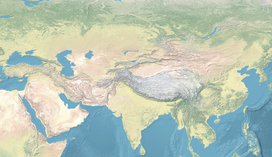| Ukok Plateau | |
|---|---|
| Укок / hohegh | |
 View of the Ukok Plateau | |
| Geography | |
Location in the Altai Republic, Russia | |
| Country | Russia |
| Federal subject | Altai Republic |
| Range coordinates | 49°18′28″N 87°35′41″E / 49.3078°N 87.5947°E |

Ukok Plateau (Russian: Укок) is a plateau covered by grasslands located in southwestern Siberia, in the Altai Mountains region of Russia near the borders with China, Kazakhstan and Mongolia. The plateau is recognized as part of the UNESCO World Heritage Site entitled Golden Mountains of Altai as an important environmental treasure. It provides a habitat for many of the world's endangered species including one of its least studied predatory animals: the snow leopard. Other endangered species protected there include the argali mountain sheep, the steppe eagle, and the black stork.[1] It is also one of the last remaining remnants of the mammoth steppe. There are several threats to the preservation of the Ukok Plateau, including overuse of the steppe by ranchers,[2] a proposed road, and plans for a gas pipeline between China and Russia.
YouTube Encyclopedic
-
1/3Views:403165 34555 123
-
mountain altai, ukok plateau! travel guide
-
The 'curse' of Siberia's 2,500-year-old 'Ice Maiden' - BBC REEL
-
Pazyryk and the Ukok Ice Maiden : In Focus
Transcription
Terminology
The Mongolian word uheg literally means "elongated cabinet", "box", "massive mountain", or big hill with a flat top. According to the oral testimony of S. Umurzakova ukok in Kyrgyz used to refer to flat-topped mountains, i.e., plateaus.[citation needed]
Geography
The Ukok Plateau is the high-mountainous plain located between South-Altai and Sailugem and ridges at a height of 2,200–2,500 m (7,200–8,200 ft) above sea level. There are 500- to 600-metre-high (1,600–2,000 ft) mountain peaks that tower above the plateau. The highest peak on the plateau is the mountain knot of Tavan-Bogdo-Ula (Five Sacred Peaks) where the highest mountain is Khüiten Peak that reaches 4,374 m (14,350 ft) above sea level. This is the second highest peak in Siberia after Belukha Mountain.[3] The present-day eastern Altai-Sayan region areas of Ukok-Sailiugem could be considered the closest analogy to the ancient mammoth steppe environment.[4]
History


Pazyryk is the name given by modern scholars to an ancient people who lived in the Altai Mountains on this plateau who are associated with some spectacular archeological findings, including mummies found frozen in the permafrost. Many ancient Bronze Age tomb mounds have been found in the area and have been associated with the Pazyryk culture which closely resembled that of the legendary Scythian people to the west.[5] The term kurgan is in general usage to describe such log-barrow burials. Excavations of this site have continued to yield notable archaeological finds.[6] One famous finding is known as the Ice Maiden, excavated by Russian archaeologist Natalia Polosmak.[7][8] At least six tattooed mummies dating from the period ca. (c. 2600 BC - AD 402) have been recovered preserved by the permafrost in tombs at sites on the Ukok Plateau including Temrta III, Primorsky I, Ak-Alakha 3, Verkh-Kaldzhin 2, and the Pazyryk burial ground.[9] The Ice Maiden and other archaeological finds were located just within a disputed strip of land between Russia and China.[10] The residents of the Altai Republic are demanding the return of the burial artifacts from their current location in Novosibirsk.[11]
Transport

The Ukok plateau is linked to the outside world by heavy-going dirt roads through the Ukok (Russia-Kazakhstan border), Ulan-Daba (Russia-Mongolia border), Teplyi kluch and Kalgutinsky passes. The Teplyi kluch pass is at an altitude of 2,907 m (9,537 ft). One may get to these passes from Kosh-Agach village, which is easily reachable owing to a relatively improved M52 highway (the so-called Chuysky tract).
Southward, beyond Kosh-Agach, the way becomes impassable for common means of transport and passable only for off-road vehicles. However, even they could become stuck in swamp mud in the Kalguty river valley, especially after a sunny day when frozen soil begins thawing. For most of the year the passes are snow-covered and avalanche-prone. During the short summer season all the slopes are prone to solifluction.
See also
References
- ^ "Protect Snow Leopard Habitat / Siberia". forests.org. Archived from the original on 2007-09-27. Retrieved 2007-07-31.
- ^ "Altai: Saving the Pearl of Siberia". Archived from the original on 2007-03-22. Retrieved 2006-11-30.
- ^ "Ukok Plateau".
- ^ Pavelková Řičánková, Věra; Robovský, Jan; Riegert, Jan (2014). "Ecological Structure of Recent and Last Glacial Mammalian Faunas in Northern Eurasia: The Case of Altai-Sayan Refugium". PLOS ONE. 9 (1): e85056. Bibcode:2014PLoSO...985056P. doi:10.1371/journal.pone.0085056. PMC 3890305. PMID 24454791.
- ^ Bahn, Paul G. (2000). The Atlas of World Geology. New York: Checkmark Books. p. 128. ISBN 0-8160-4051-6.
- ^ "Golden Mountains of Altai". UNESCO. Retrieved 2007-07-31.
- ^ "Ice Mummies: Siberian Ice Maiden". PBS - NOVA. Retrieved 2007-07-31.
- ^ "Prehistoric Art - Early Nomads of the Altaic Region". The Hermitage Museum. Archived from the original on 2007-06-22. Retrieved 2007-07-31.
- ^ Deter-Wolf, Aaron; Robitaille, Benoît; Krutak, Lars; Galliot, Sébastien (February 2016). "The World's Oldest Tattoos". Journal of Archaeological Science: Reports. 5: 19–24. doi:10.1016/j.jasrep.2015.11.007. S2CID 162580662.
- ^ Leigh Fenly (December 8, 2004). "Archaeology News". Archived from the original on August 2, 2009. Retrieved 2007-11-27.
- ^ "Minor nationality of Russia demands the return of "Princess of Ukok"". Pravda. February 21, 2005. Retrieved 2007-11-27.
Further reading
- S.I. Rudenko, Kul'tura naseleniia Gornogo Altaia v skifskoe vremia ("The Population of the High Altai in Scythian Times")(Moscow and Leningrad, 1953) translated as Frozen Tombs of Siberia: The Pazyryk Burials of Iron Age Horsemen, M.W. Thompson, tr. (University of California Press, Berkeley) 1970. ISBN 0-520-01395-6
External links
- Photos of Ukok Plateau - Altai-Photo
- Greater Altai – Altai Krai, Republic of Altai, Tyva (Tuva), and Novosibirsk
- A collection at Novosibirsk State University site, including Pazyryk
- Life in Ukok Plateau photostory


